Our official English website, www.x-mol.net, welcomes your feedback! (Note: you will need to create a separate account there.)
Ultralow-power chip-based soliton microcombs for photonic integration
Optica ( IF 10.4 ) Pub Date : 2018-10-19 , DOI: 10.1364/optica.5.001347 Junqiu Liu , Arslan S. Raja , Maxim Karpov , Bahareh Ghadiani , Martin H. P. Pfeiffer , Botao Du , Nils J. Engelsen , Hairun Guo , Michael Zervas , Tobias J. Kippenberg
Optica ( IF 10.4 ) Pub Date : 2018-10-19 , DOI: 10.1364/optica.5.001347 Junqiu Liu , Arslan S. Raja , Maxim Karpov , Bahareh Ghadiani , Martin H. P. Pfeiffer , Botao Du , Nils J. Engelsen , Hairun Guo , Michael Zervas , Tobias J. Kippenberg

|
The generation of dissipative Kerr solitons in optical microresonators has provided a route to compact frequency combs of high repetition rate, which have already been employed for optical frequency synthesizers, ultrafast ranging, coherent telecommunication, and dual-comb spectroscopy. Silicon nitride () microresonators are promising for photonic integrated soliton microcombs. Yet to date, soliton formation in microresonators at electronically detectable repetition rates, typically less than 100 GHz, is hindered by the requirement of external power amplifiers, due to the low quality () factors, as well as by thermal effects that necessitate the use of frequency agile lasers to access the soliton state. These requirements complicate future photonic integration, heterogeneous or hybrid, of soliton microcomb devices based on microresonators with other active or passive components. Here, using the photonic Damascene reflow process, we demonstrate ultralow-power single-soliton formation in high- microresonators with 9.8 mW input power (6.2 mW in the waveguide) for devices of electronically detectable, 99-GHz repetition rate. We show that solitons can be accessed via simple, slow laser piezo tuning, in many resonances in the same sample. These power levels are compatible with current silicon-photonics-based lasers for full photonic integration of soliton microcombs, at repetition rates suitable for applications such as ultrafast ranging and coherent communication. Our results show the technological readiness of optical waveguides for future all-on-chip soliton microcomb devices.
中文翻译:

超低功耗基于芯片的孤子微梳子,用于光子集成
光学微谐振器中耗散Kerr孤子的产生为高重复频率的紧凑频率梳提供了一条途径,这些频率梳已经用于光学频率合成器,超快测距,相干电信和双梳谱。氮化硅(微谐振器有望用于光子集成孤子微梳。迄今为止,尚无孤子形成 由于质量低,外部功率放大器的需求阻碍了电子谐振频率通常小于100 GHz的微谐振器的出现()因素以及热效应,这些效应需要使用频率捷变激光器来访问孤子状态。这些要求使基于以下的孤子微梳器件的未来光子集成(异构或混合)复杂化微谐振器以及其他有源或无源组件。在这里,我们使用光子大马士革回流工艺,证明了高能级中的超低功率单孤子形成 具有9.8 mW输入功率(波导中为6.2 mW)的微谐振器,用于电子可检测的99 GHz重复频率的设备。我们显示,可以通过简单,缓慢的激光压电调谐来访问孤子,并且可以在同一样本中进行多次共振。这些功率水平与当前的基于硅光子学的激光器兼容,可实现孤子微梳子的完整光子集成,其重复频率适用于超快测距和相干通信等应用。我们的结果表明, 未来的全芯片孤子微梳器件的光波导。
更新日期:2018-10-19
中文翻译:

超低功耗基于芯片的孤子微梳子,用于光子集成
光学微谐振器中耗散Kerr孤子的产生为高重复频率的紧凑频率梳提供了一条途径,这些频率梳已经用于光学频率合成器,超快测距,相干电信和双梳谱。氮化硅(微谐振器有望用于光子集成孤子微梳。迄今为止,尚无孤子形成 由于质量低,外部功率放大器的需求阻碍了电子谐振频率通常小于100 GHz的微谐振器的出现()因素以及热效应,这些效应需要使用频率捷变激光器来访问孤子状态。这些要求使基于以下的孤子微梳器件的未来光子集成(异构或混合)复杂化微谐振器以及其他有源或无源组件。在这里,我们使用光子大马士革回流工艺,证明了高能级中的超低功率单孤子形成 具有9.8 mW输入功率(波导中为6.2 mW)的微谐振器,用于电子可检测的99 GHz重复频率的设备。我们显示,可以通过简单,缓慢的激光压电调谐来访问孤子,并且可以在同一样本中进行多次共振。这些功率水平与当前的基于硅光子学的激光器兼容,可实现孤子微梳子的完整光子集成,其重复频率适用于超快测距和相干通信等应用。我们的结果表明, 未来的全芯片孤子微梳器件的光波导。


























 京公网安备 11010802027423号
京公网安备 11010802027423号